
Applying Cross-Domain Thinking
– the phenomena in general
– how individuals do them
– and how to increase our capacity to move from one to the other.
Domain Dependence
Some people can understand an idea in one domain, say medicine, and fail to recognize it in another, say socioeconomic life. Or they get it in the classroom, but not, in the more complicated texture of the street. Humans somehow fail to recongize situations outside of contexts in which they usually learn about them.
I had a vivid illustration of domain dependence in the driveway of a hotel of the pseudocity of Dubai. A fellow who looked like a banker had a uniformed porter carry his baggage. About 15 minutes later I saw the banker lifting free weights at the gym, trying to replicate natural exercises using kettle bells as if he were swinging a suitcase. Domain dependence is pervasive.
We are all, in a way, similarly handicapped, unable to recognise the same idea when it’s presented in a different context. It is as if we are doomed to be deceived by the most superficial part of things, the packaging, the gift wrapping. We don’t see antifragility it is not part of the accepted way of thinking about success, economic growth, or innovation. And domain dependence is also why it has been difficult for many researchers to realize that uncertainty, incomplete understanding, disorder, and volatility are members of the same close family. This lack of translation is a mental handicap that comes with being a human; and we will only start to attain wisdom or rationality when we make an effort to overcome and break through it. (Antifragile, 2012, pp. 38-40)
5 Principles of Creativity – Why it Works – Part 4: Cross Domains
Of all the creativity techniques, getting used to cross-domain thinking can be the most rewarding and can sometimes lead to quick results. It can also make you look slightly crazy. In short if you are looking to increase your creative output in the shortest time, with the least effort, then cross domain thinking is the best way to do this – as long as you are comfortable coming up with some fairly ‘left-field’ ideas.
So why is cross-domain thinking so important?
First off is that much of creativity is about the recombination of ideas. There a very few ideas that are truly original. Asking someone to come up with a creative idea that has not been thought of before is an extremely difficult assignment. It’s a lot easier, and a lot more productive to look around at ideas in use within other fields.
The second reason that cross domain thinking is so valuable is because chances are, the problem you are trying to deal with has already been solved somewhere else – and solved well. Someone somewhere HAS to get that little irritating problem that you would like to solve right. For example, if you have a quality issue, then look to the airline industry – where they NEED to get quality right. If you have a rapid response issue then look to law enforcement. Again, what may be a valuable need for you is essential for them. Cross domain thinking provides ready access to well understood and mature best-practice solutions.
The third reason is that cross domain thinking (once you get used to it) is a lot easier than delving deeper into one domain. The learning load of continuing to expand knowledge deeper into the crevices of a single discipline is high whereas a large amount of potentially useful concepts and information can be gathered from a different field in a very short period of time.
Finally with cross domain you are more likely to come up with a unique combination that hasn’t been tried before. If you want an example of how combining apparently unrelated concepts can be hugely rewarding just think of mixing wizards with boarding school and the success of the Harry Potter franchise.
There appears to be a growing interest in the value that generalists can provide to an organisation and a slight stepping back from super specialists. The benefits of cross-domain thinking may in fact be behind this new found interest in generalists.
lessonsfromdotdotdot.blogspot.co.uk/2013/02/5-principles-of-creativity-why-it-works_20.html
State- and context-dependent memory, behaviour and learning
State-dependent learning or state-dependent memory is the phenomenon in which the retrieval of a memory is most effective when an individual is in the same state of consciousness as they were when the memory was formed. Unlike context-dependent memory which involves an individual’s external environment, state-dependent memory applies only to the individual’s internal world.
Ernest Rossi, in his extensive investigation of The Psychobiology of Mind-Body Healing, says creativity involves breaks in state-dependency:
What we usually experience as our ordinary everyday state of awareness or consciousness is actually habitual patterns of state-dependent memories, associations, and behaviours. I have conceptualized ‘creative moments’ in dreams, artistic and scientific creativity, and everyday life as breaks in these habitual patterns. The new experience that occurs during creative moments is regarded as ‘the basic unit of original thought and insight as well as personality change’.
Metaphor as cross-domain mapping
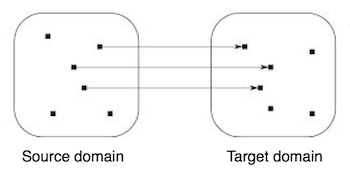
The locus of metaphor is not in language at all, but in the way we conceptualize one mental domain in terms of another. The general theory of metaphor is given by characterizing such cross-domain mappings. And in the process, everyday abstract concepts like time, states, change, causation, and purpose also turn out to be metaphorical. The result is that metaphor (that is, cross-domain mapping) is absolutely central to ordinary natural language semantics, and that the study of literary metaphor is an extension of the study of everyday metaphor. Everyday metaphor is characterized by a huge system of thousands of cross-domain mappings, and this system is made use of in novel metaphor. Because of these empirical results, the word metaphor has come to be used differently in contemporary metaphor research. The word metaphor has come to mean a cross-domain mapping in the conceptual system. The term metaphorical expression refers to a linguistic expression (a word, phrase, or sentence) that is the surface realization of such a cross- domain mapping (this is what the word metaphor referred to in the old theory).
What is domain specificity and why is it necessary?
Edward H. Hagen, Institute for Theoretical Biology, Berlin:
Domain specificity is an important property of physiological adaptations, and is presumed to be an important property of psychological adaptations as well. Domain specificity means that adaptations evolve to solve problems in particular domains, and therefore are less well suited to solve problems in other domains.
Evolutionary psychology is betting that psychological adaptations have to be just as domain specific as physiological adaptations. Information processing appears to be an excellent model for the general class of problems solved by psychological mechanisms. In the field of information processing, no one has invented a computer program that solves all problems. Each information processing problem requires specialized software to solve that problem. Spreadsheets are different from word processors are different from video games. Similarly, vision is different from hearing is different from pain is different from smell is different from sexual desire is different from navigation. In short, transformations of information are just as specialized as any other physical transformation and require equally specialized mechanisms to complete the task. Thus, psychological adaptations are as likely to be as domain specific as any other adaptation.
www.anth.ucsb.edu/projects/human/epfaq/domain.html
A spectrum of domain dependence and cross-domain thinking
Too much domain dependence
Appropriate amount of domain dependence
Not enough domain dependence
Not enough cross-domain thinking
Appropriate amount of cross-domain thinking
Too much cross-domain thinking
The spectrum from too much to too little might look something like this:
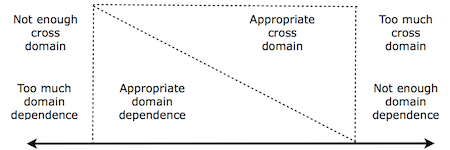
can you find examples for each category?
Four ways to think across domains
Direct – (horizontal) link between items in two domains:

Up-down – Identify a pattern in one domain and find examples of that pattern in another domain:
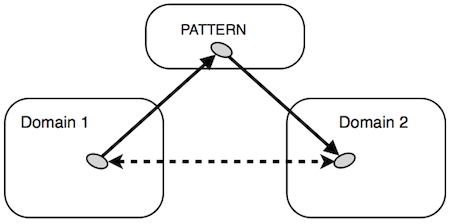
Down-Up – Take an example from one domain and find an equivalent in another domain:
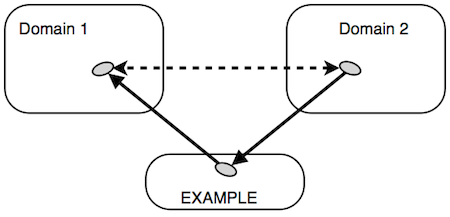
Broaden – Widen the boundary of the domain and then find links within the widened domain:
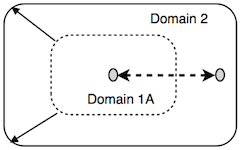
Model fertility
Hegelian dialectic
Serendipity
Royston Roberts asks:
What do Velcro, penicillin, X-rays, Teflon, dynamite, and the Dead Sea Scrolls have in common? Serendipity! These diverse things were discovered by accident, as were hundreds of other things that make everyday living more convenient, pleasant, healthy, or interesting. All have come to us as a result of serendipity — the gift of finding valuable or agreeable things not sought for or ‘the faculty of making fortunate or unexpected discoveries by accident’. (Serendipity: Accidental Discoveries in Science, p. ix)
Many things exist today because someone made an unexpected connection across two distinct domains. For example, Velcro came about because George de Mestral made the link between burrs on a sock and a new kind of fastener. For more on serendipity see:
cleanlanguage.co.uk/articles/articles/224/1/Maximising-Serendipity/
cleanlanguage.co.uk/articles/blogs/85/Maximising-Serendipity-for-Personal-Change.html
Adjacency (proximity)
Effects of Technology
Because the spatial divide can be collapsed, and one can work where once one only played or play where once one worked, it does sometimes seem that traditional boundaries between cultural domains such as work and home have collapsed. Technology provides the potential for increasing the integration between these domains functionally and subsequently, conceptually.
Fitness landscapes
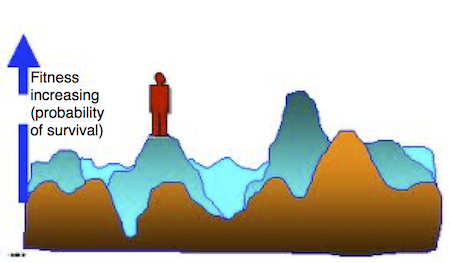
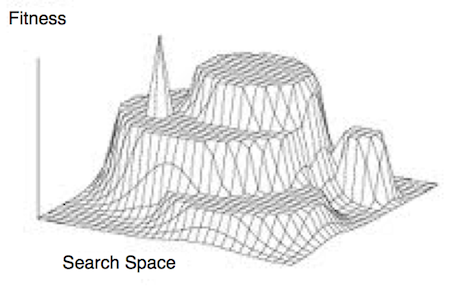
First published at cleanlanguage.co.uk.
Image – depositphotos







